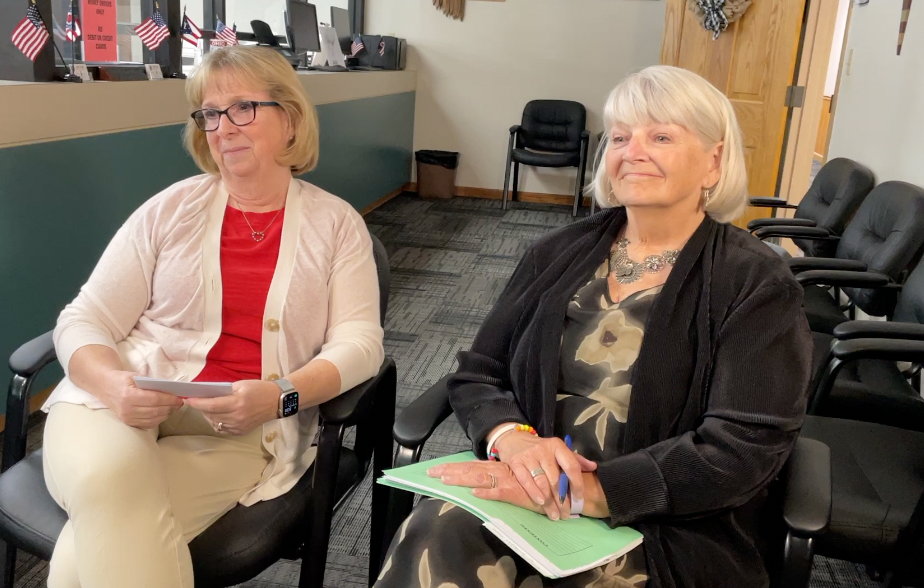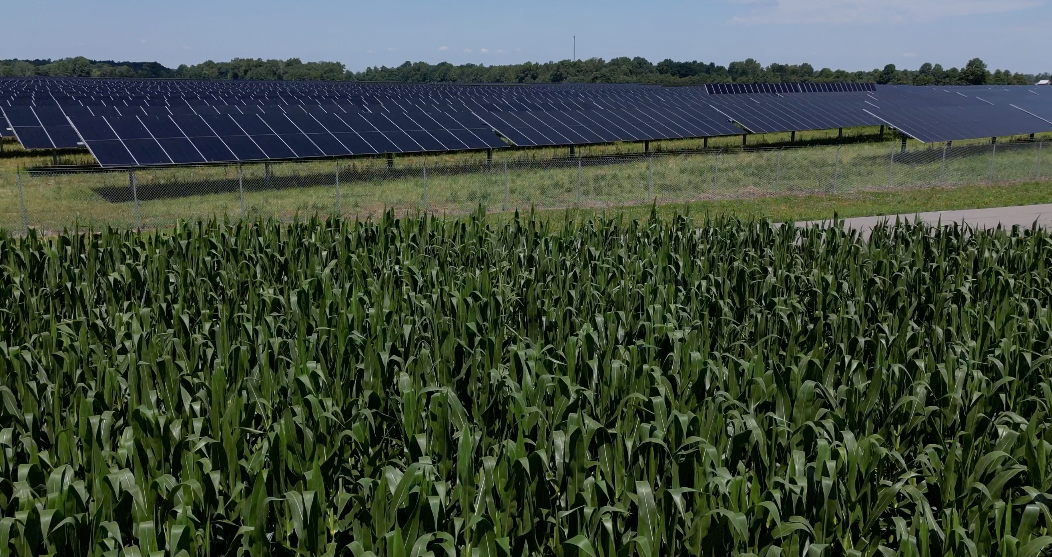MOUNT ORAB, Ohio — Some farmers describe it as the hardest decision they’ve ever made: Lease to solar companies for a life-changing payout or risk the wrath of neighbors and the productivity of their farmland to bear future crops.
“I’ve seen brother turned against brother. It’s split up families. It’s split up neighbors,” said Becky Williams who is set to have a new solar farm built across the street from her Highland County home, in what is now a cornfield. “It’s definitely divided the community, and only a few seemed to have profited.”
Hundreds of rural landowners in Southwest Ohio have already made the choice or will be contemplating it soon, as solar companies from across North America target the area for solar farm growth.
Already nine large-scale solar projects are either operational, under construction or planned for four counties within an hour’s drive of Cincinnati in Clermont, Clinton, Highland and Brown.
Drawn here by flat farmland and abundant sunshine, some solar developers are willing to pay more than $1,000 an acre, per year, to farmers who own land along the valuable PJM Interconnection transmission network. That’s three times more than farmers can earn growing crops.
Ohio is attractive to solar companies because it is part of a 14-state transmission network that has open circuits for solar farms to generate more power. The PJM network coordinates the movement of wholesale electricity in the mid-Atlantic, from Illinois to New Jersey.
“In your area, I started meeting with farmers 10 to 12 years ago because you had a lot of different developers from other parts of the United States come and talk to them about leasing agreements,” said Dale Arnold, director of energy, utility, and local government policy at the Ohio Farm Bureau Federation.

“Especially in north central and western Ohio, there's a number of transmission circuits that have additional capacity or room to put megawatt-scale power generation into the system," said Arnold who travels the state advising local governments and landowners on solar.
One of the first, and one of the largest is Amazon Solar Farm Ohio – Hillcrest which sits on more than 2,000 acres near Mt. Orab. It began producing energy in 2021 and the state declared it fully operational late last year.
“When all this started it sounded like such a great idea,” said Aubrey Bolender, vice chair of the Brown County Soil and Water Conservation District Board. “Then when construction started that’s when it became real for the residents.”

Construction crews rerouted ditches, causing flooding on neighboring farms. They hauled away valuable topsoil by dump truck, and ran heavy equipment over wet soil compacting it and hurting its future productivity, Bolender said.
“There should be rules to make sure it doesn’t happen but there wasn’t anything in place to stop it,” Bolender said. “There wasn’t any local oversight to make sure that it wouldn’t happen.”
State records show the Hillcrest project was built according to its permit. But Bolender blames lax oversight by the Ohio Power Siting Board and the Ohio EPA over the new solar industry, and the inability for local officials to get involved.

A spokesperson for Hillcrest’s owner, Canada-based Innergex Renewable Energy, said any complaints that emerged from the construction and early operations of the project have been resolved.
“We repaired, and in most cases improved infrastructure compared to the baseline conditions and consulted with individual landowners to ensure their satisfaction,’ said spokesperson Guillaume Perron-Piche. “Based on community feedback, Innergex planted additional vegetative covering compared to the initial plan that was approved by the Ohio Power Siting Board. As the vegetation grows, we are confident that the fencing will be less visible.”
Chad and Melanie Hawk leased roughly 450 acres of farmland, making them the largest land contributor to the Hillcrest project.
“The money got everybody’s attention,” said Chad Hawk, noting that they turned down prior solar contracts because they could earn more farming. “But when they gave us a we-hit-the-lottery kind of number, we were like well maybe this is something we should consider.”
They used that money to buy Melanie’s parents' 183-acre farm and repair it, pay off debt, buy new farming equipment and build a barn. They expanded their Black Angus cattle herd, began raising chickens and feel confident that they will be able to preserve their farmland.
“Financially it’s put us in a good spot where our kids and our grandkids can farm down the road,” Chad Hawk said.
The worst criticisms the Hawks said they've received from neighbors is that solar "takes crops out of the ground," and "it's ugly, I don't want to look at it."

Another resident who leased land for the Hillcrest project told WCPO that he was having trouble selling his house, due to so much criticism on social media.
"To know they are opposing it just because they don’t like the way it looks — I have a big problem with," Melanie Hawk said. "Because it increases the tax revenue to the school district. It increases the tax revenue to our township trustees."
She installed beehives on land near the solar panels and sees more bees and butterflies now because the land isn’t being sprayed with chemicals for farming.
“There’s not a doubt in my mind that we’ll be able to farm this at the end of the solar lease,” Melanie Hawk said.
She encouraged anyone who is considering leasing their farmland to a solar company to first hire a lawyer to review potential contracts.
“It wasn’t something that we signed on the hood of a pickup truck,” she said. “We wanted to make sure that we got our farm ground back better or in just as good a shape as what it was. Before we even signed the lease, there was that decommissioning part of the contract that we as landowners sought out.”
Farmers need to ask about the type of solar panels being installed, fencing setbacks, drainage systems, soil and water conservation, and soil compaction, said Arnold, whose bureau offers an attorney referral network of law firms that specialize in this type of work.

“Many folks have done that in your particular area, and many other folks have not,” Arnold said. “This is a much more complex issue than what some people realize when they first start.”
The Hawks said they received their lease payments from Innergex on time, but that did not happen to Brown County officials.
Under their agreement, the PILOT payment, or payment in lieu of taxes, received by the county, Green Township and local schools is set at $1.8 million per year.
“They’ve actually been actively producing electric, at least a good portion of it, since June or July of 2021,” said Brown County Auditor Jill Hall. “We’ve known all along and we’ve been wondering.”
But the state Department of Development determines when a solar project is considered fully operational, and the PILOT payments kick in. Hall said she didn’t get the letter from the state until January 4 — nearly five years after the state first approved the application to build.

“I told the township immediately because they were concerned about repairing roads. That was their high concern. I let the schools know because of course they were interested in seeing if they were going to get their money,” Hall said.
When the money didn’t arrive when it was due in early February, Treasurer Connie Patrick started calling the state Department of Development.
“There was no one available to even field my calls basically,” Patrick said. “Once we finally did get their attention that ‘Hey things aren’t happening - we are supposed to report the payment but there was no way to report the nonpayment.'”
In early March, the county finally received its $1.8 million plus a 10% late fee, which Patrick said Innergex officials asked her to waive.
“By law, we’re required to charge 10% after the due date and that’s what we did,” Patrick said. “Hopefully the hurdles and glitches are behind us, and we’ll move forward now with a better understanding of each other, what’s expected, what’s required.”

An Innergex spokesperson confirmed that the PILOT payment was made but did not say why it was late.
“I think this being the first big project in the state of Ohio I’m going to give them the benefit of the doubt,” Hall said. “Somebody needs to have their finger on it all the time.”
She hopes the lessons learned from Amazon Hillcrest will prompt better outcomes for future solar projects. In October, crews broke ground on Clermont County’s first large-scale solar project, Nestlewood, on 610 acres of farmland in a small portion of Tate Township that stretches largely into Brown County.
Residents complained about construction noise, dust, traffic and the loss of farmland prompted. Clermont County commissioners voted to ban large-scale solar farms in seven townships last month, where one resident described Nestlewood as "almost 700 acres of pure hell."
In the past year, Butler and Brown County commissioners voted to ban future large-scale solar projects.
These bans only apply to large solar farms. Smaller ones, under 50 megawatts, are not regulated by the state and will be overseen by townships and local governments.
Many local officials are rushing to write rules to oversee these smaller solar farms, which can be strung together to create a larger footprint before they arrive in mass.

“What I’ve learned is that we need to slow down … there’s got to be a lot of legislation done first to make sure there are rules in place that don’t allow things like topsoil removal,” Bolender said. “Farmers have to follow a lot of regulation. If we have to follow those rules, then the solar companies should also have to.”
Bolender is pushing for more local oversight on solar projects and fears that without it, she and her family could someday be living in a solar wasteland.
“Landowners are still getting hit really hard with salesmen from the solar companies wanting to sign them up for leases, and they need to just wait,” said Bolender. “The solar companies are pushing really hard for folks to sign these leases because then they’ll be grandfathered in prior to the rules and regulations. That’s what learned the most from … Hillcrest and Nestlewood."
Note: Coming up Thursday, Part 2 of this series will focus on the New Market Solar project in Highland County where the city of Cincinnati is buying its energy.





